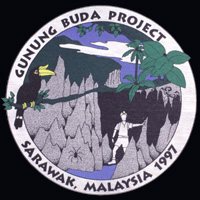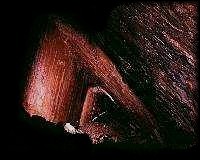|

|

The
Gunung Buda Project
|
|
Expedition
Photos
See
Andy Porter's Expedition Photos
(as
of 4/22)
|
|
The Gunung
Buda Project:
Founded in 1996, the Gunung Buda Project seeks to
protect and preserve the Gunung Buda (White
Mountain) Massif on the island of Borneo in
Sarawak, Malaysia as a Malaysian National Park.
This outstanding region of lowland tropical rain
forest has fantastic caves including some of the
longest and deepest caves in Southeast Asia. The
project is primarily made-up of American and
British cavers and cave scientists who enjoy cave
exploration, survey, photography and research. Most
of the project members are also members of the
National
Speleological Society
(NSS).
The Gunung Buda Project is a project of the NSS.
|
|
|
Of tremendous importance to the success of the
Project and expeditions that visit Gunung Buda are
the many Malaysians who either work for the
Forestry Department of Sarawak, nearby
Gunung
Mulu National Park, or are
local Tabuan people or who are employed by our
Outfitter, Tropical Adventures. Malaysians act as
guides through the local jungles and caves, assist
with the cave surveys and research and on the 1997
expedition saved the lives of a television crew
that fell into a deep pool of turbulent water. Our
hosts have provided us with many fine meals
harvested from the tropical forests and have set us
straight on the dangers of the jungle and
caves.
|
|
The Gunung Buda Area was first
visited by British cavers in 1984. They
found the entrances and initial passages
to several large caves. These explorers
were part of a larger effort investigating
the caves further south in what would
become Gunung Mulu National Park. This
area has some of the world's most amazing
caves including Clearwater, the tenth
longest cave in the world, Deer Cave the
largest cave passage in the world, and the
Sarawak Chamber the largest cave room in
the world, which is roughly a half mile
long, a quarter mile wide and has a
400-foot-high ceiling. Americans first
visited Gunung Buda when John Lane and
George Prest visited the mountain to
assess its potential for an American
expedition in 1993. In late 1994 and early
1995 the first American expedition took
place. Other followed in 1996 and 1997.
Collectively the expeditions have surveyed
more than 60 kilometers of cave passages
beneath Gunung Buda.
|

|
|
|
The rain forests of Buda and nearby Mulu host
a tremendous diversity of life including at least
300 birds species, numerous primates, more than
2,500 tree species, more than 60 snakes and many
other beautiful varied forms of life. The climate
is wet year around and temperatures climb into the
mid-80s Fahrenheit every day. Changes in substrate,
slope, elevation and drainage make the forests of
the area particularly varied. At Gunung Buda,
limestone forest, lowland dipterocarp forests,
kerangas swamp forests and upland dipterocarp
forests all grow.
- Joel Despain
|
All text
and pictures copyright the Gunung Buda Project 1995 -
2000
Send
comments, suggestions and inquiries
to: apfrantz@pwpconsult.com
Page last
updated 12/3/00
|